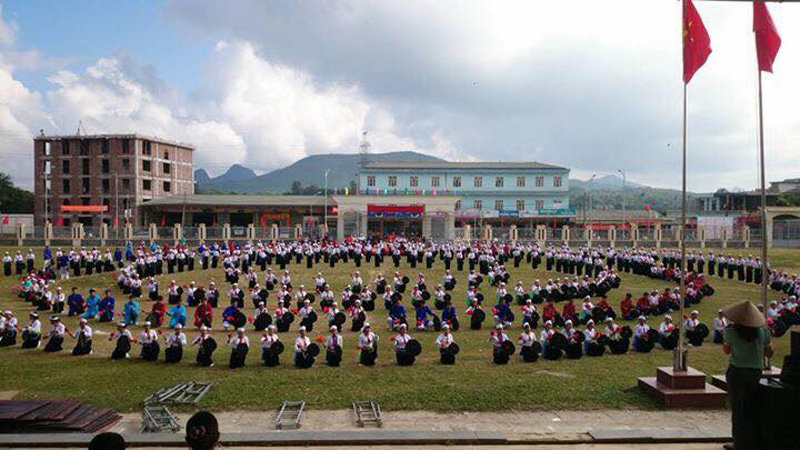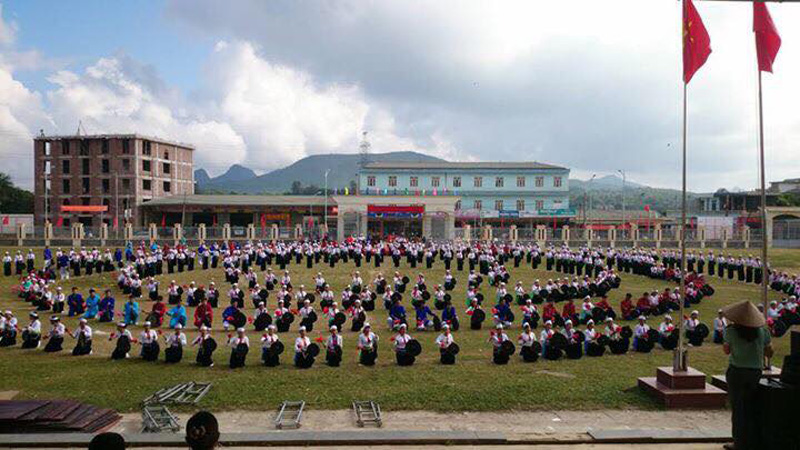
(HBO) – For Muong ethnic people in the northern province of Hoa Binh, especially those from Lac Son district, gong is a national instrument with the most sacred sound in their cultural life.

A Muong gong
performance at a celebration of the 130th founding anniversary of Lac Son
district (in 2016). File photo
To preserve and develop the Muong gong culture
and realise a project on the preservation and development of cultures of
Vietnamese ethnic minority groups through 2020 approved by the Prime Minister,
Lac Son district has carried out a number of measures, including promoting the
role of the community in preserving intangible culture, particularly gong
culture. Along with the development of mass culture and art movements at
grassroots level, the district has encouraged people to play gongs at sport and
culture programmes and big festivals of communes.
Notably, in August 2017, the district opened a
training course on Muong gong art for nearly 150 artisans and cultural
officials of 29 communes and towns. According to Bui Thi Thuy, head of the district’s
culture-sport office, Lac Son is one of the first localities in the province to
organise such a class. A set of gongs consists of 12 units representing 12
months in a year. There are basic regulations. For example, a band needs one or
two people who can sing the opening song before entering a family to wish them
a happy Tet (Lunar New Year). Gong is believed to bring luck to families and
happiness to couples in their wedding days. It also means seeing off the
deceased and calling on people to go to the field and share joy over new crops
as well as driving away bad luck in life and bringing in warmth and
blissfulness. Therefore, gong is considered the most sacred musical instrument
passed from generations to generations, becoming an indispensable cultural
feature.
Artisan Quach Thanh Vin in Chay hamlet of Lien Vu
commune, who is considered the soul of the training classes, said thanks to the
classes, young people and local residents know how to play traditional gong (xac
bua) melodies. There are also some taboos on gong such as not putting the
instrument on the floor. Regardless of the space such as on stilt houses or in
the yard and public places, gong must be played in a methodological manner.
When performing on the stage, gong players have
to use not only their eyes but also their ears to feel the sound and play
melodies flexibly. Training on gong uses both easy and difficult songs which
include popular melodies in Muong Vang and those hailing from other regions due
to cultural exchange.
Statistics show that there are more than 3,500 gongs
across Lac Son district at present. The musical instrument is often used in
local festivals and cultural activities.
With an increasingly vibrant and widespread emulation movement aimed at building cultured residential areas and cultured families, Yen Thuy District has been making steady progress toward improving both the material and spiritual well-being of its people, while fostering a civilized, prosperous, beautiful, and progressive community.
Once lacking recreational spaces and community facilities, Residential Group 2 in Quynh Lam Ward (Hoa Binh City) has recently received attention for the construction of a new, spacious, and fully equipped cultural house. The project followed the model of state support combined with public contributions in both labor and funding.
The "All people unite to build cultural life" movement, which has been effectively integrated with Kim Boi district’s socio-economic development goals, is fostering a lively spirit of emulation across local residential areas, hamlets, villages, public agencies, and enterprises. In addition, through the initiative, traditional cultural values are being preserved and promoted, while community solidarity and mutual support in poverty reduction and economic development are being strengthened.
A working delegation of the Hoa Binh provincial People’s Committee led by its Permanent Vice Chairman Nguyen Van Toan on June 11 inspected the progress of a project to build the Mo Muong Cultural Heritage Conservation Space linked to tourism services in Hop Phong commune, Cao Phong district.
Born and growing in the heroic land of Muong Dong, Dinh Thi Kieu Dung, a resident in Bo town of Kim Boi district, in her childhood was nurtured by the sweet lullabies of her grandmother and mother. These melodies deeply imprinted on her soul, becoming an inseparable part of her love for her ethnic group's culture. For over 20 years, this love for her hometown has driven Dung to research, collect, and pass down the cultural values of the Muong people to future generations.
In the final days of May, the Ethnic Art Troupe of Hoa Binh Province organized performances to serve the people in remote, mountainous, and particularly disadvantaged areas within the province. These were not just ordinary artistic shows, but they were the meaningful journeys aimed at spreading cultural values, enhancing the spiritual life of the people and contributing to the preservation of ethnic minority cultural identities.



